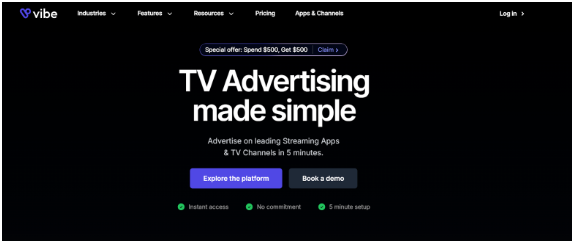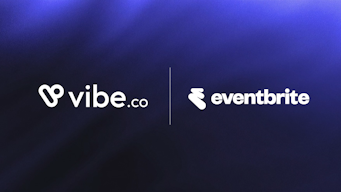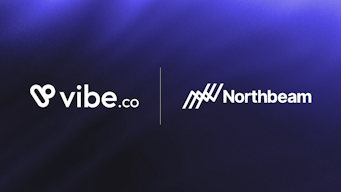Performance TV Advertising: 5 Key Things To Know About
Are your TV ads delivering real results? Traditional TV offers reach, but it can’t show who watched it or if it worked.
Performance TV advertising changes that. It combines TV’s reach with precise targeting and real-time tracking, so your ads reach the right people and deliver measurable results.
In this blog, you’ll learn:
- What Performance TV advertising is.
- How it’s different from traditional TV ads.
- Ways to target better and track ROI.
- How tools like Vibe.co can help.
Ready to make your TV ads smarter? Let’s get started!
5 Key Things to Know About Performance TV Advertising
Here’s a quick snapshot of the 5 key things to know about performance TV advertising you’ll learn in this blog:
| Key Things to Know | Why It Matters |
|---|---|
| 1. What It Is | Performance TV advertising combines TV reach with digital-like tracking, making ads measurable and actionable. |
| 2. How It’s Different | Unlike traditional TV ads, it lets you target specific audiences and track results in real time. |
| 3. Master Real-Time Targeting | Delivers ads to the right audience at the right time, improving engagement and ad relevance. |
| 4. Tracking Results | Helps you measure performance using clear metrics like views, clicks, and conversions. |
| 5. Solving Challenges | Tools like Vibe.co simplify campaign management and analytics, saving time and effort. |
What is Performance TV Advertising?
Performance TV advertising is a way to show ads on TV while tracking how well they work, just like digital ads.
Unlike traditional TV ads, which are about reaching as many people as possible without knowing who is watching, performance TV advertising uses data to target specific groups of people and measure results.
For example, if you are selling fitness equipment, you can use performance TV to show your ads to people who are already interested in fitness.
Performance TV uses platforms like Connected TV (CTV) and Over-the-Top (OTT) services.
- CTV is any TV that connects to the internet, like a smart TV. OTT refers to streaming services like Hulu or Roku that deliver content over the internet instead of through traditional cable.
- The main feature of performance TV advertising is that it combines the wide reach of TV with the precision of online ads.
- You get the ability to target specific audiences, track results, and adjust your campaigns based on what works.
- This method is useful because it allows you to spend your advertising budget more effectively, focusing on the people who are most likely to respond to your ads.
It’s a smarter way to use TV for marketing.
Performance TV Advertising vs. Traditional TV Ads: What is the Difference?
Below is a clear comparison across three key areas: targeting, measuring results, and cost-efficiency.
| Aspect | Traditional TV Ads | Performance TV Ads |
|---|---|---|
| Targeting | Your ads are shown to everyone, even those not interested. Example: A workout ad on a sports show. | Your ads are shown to specific audiences. Example: A workout ad on fitness content on Hulu. |
| Measuring Results | You rely on TV ratings to estimate viewers. You can’t track who saw your ad or if it led to sales. | You can track views, clicks, and purchases. Example: 500 clicks and 50 sales. |
| Cost-Efficiency | You pay for a broad reach, including uninterested viewers. | You spend only on relevant audiences, reducing wasted spend. |
Traditional TV ads might work well for general brand awareness, but if you want targeted, measurable results, Performance TV advertising is the smarter choice.
In the next section, we’ll learn how performance TV uses real-time data to reach your ideal audience, making your campaigns even more effective.
How Performance TV Advertising Uses Data to Reach the Right Audience
Performance TV advertising ensures your ads reach the right audience by using real-time data and audience insights.
Unlike traditional TV ads that broadcast to everyone watching, performance TV allows you to focus on specific groups who are most likely to engage with your message.
Let’s break this down step by step.
1. Real-Time Targeting: Delivers Ads When It Matters Most
Performance TV uses real-time data to decide when and where to show your ads. This ensures your ad reaches viewers when they’re actively engaged.
- Streaming platforms like Hulu or Roku analyze what viewers are watching at any given moment. Based on this, your ads are placed alongside relevant content.
- For example, if you’re a sportswear brand, your ad could play during a fitness documentary on Hulu. This means your ad is shown to viewers already interested in fitness-related content, increasing the chance they’ll respond.
2. Audience Segmentation: Focus on the Right Groups
One of the most powerful features of performance TV advertising is its ability to divide viewers into smaller, more specific groups based on shared traits.
This process, called audience segmentation, helps ensure your ads are shown to the right people, increasing their effectiveness.
Let’s explore some common ways to segment audiences:
- By Demographics: You can target viewers by their age, gender, or income. For example, a luxury car brand could focus its ads on viewers with higher incomes, ensuring the message reaches an audience that’s more likely to be interested.
- By Location: Performance TV allows you to show ads based on where viewers live. For instance, a local restaurant could target people within a 5-mile radius, making the ad more relevant to potential customers nearby.
- By Interests or Behavior: Ads can also be tailored based on what viewers watch or do. For example, someone who frequently streams cooking shows might see ads for kitchen gadgets or meal delivery services.
During special times of the year, segmentation becomes even more important.
For example, during the holiday season, a toy brand could target parents by showing ads during family movies on Roku.
This ensures the ad is not only timely but also relevant to the audience watching.
3. Data Sources: Where Does the Targeting Data Come From?
Performance TV relies on multiple data sources to find the right audience. These include:
- First-Party Data: Data collected from your own customers, like purchase history or website activity. For example, a pet store might target customers who recently bought dog food.
- Third-Party Data: Platforms like Hulu or Roku provide data on what viewers prefer. For example, a travel agency could target viewers who frequently watch adventure documentaries.
- Behavioral Data: Tracks what viewers watch, search for, or engage with. A fitness company might target users who consistently stream workout videos.
4. Why Relevance Matters: Better Engagement and Results
When your ads match what viewers are interested in, they feel personal and less disruptive. This makes people more likely to notice and act.
For example:
- Home Renovation Fans: If someone loves home renovation shows, an ad for home improvement tools feels relevant and useful.
- Travel Enthusiasts: A travel company promoting beach vacations could show ads to viewers watching tropical-themed content. Since the ad complements what they’re watching, it creates a stronger connection.
By using data to guide your targeting, you can:
- Reach the right audience.
- Avoid spending on people who aren’t interested.
- Focus your budget on those more likely to respond.
This approach makes your campaigns more efficient and delivers better results.
Up next, we’ll cover how to measure your campaign’s success and track ROI. This is where performance TV advertising truly stands out!
How to Track ROI in Performance TV Advertising
Tracking ROI in Performance TV advertising helps you see exactly how your campaigns are performing. When you know your ROI, you can:
- Focus your budget on campaigns that deliver results.
- Stop wasting money on ads that don’t work.
- Understand how your campaigns impact your revenue.
For example, if you’re advertising fitness gear, ROI tracking can show whether viewers clicked your ad, visited your website, and purchased your product.
Without this data, you’d be guessing instead of improving.
A. What Metrics to Track in Performance TV Advertising
To understand and improve your campaign’s performance, track these four key metrics. They provide a clear view of how your ads are performing and where to optimize.
| Metric | What It Measures | How to Calculate | Example | Benchmark/Insights |
|---|---|---|---|---|
| Impressions | Number of times your ad is displayed to viewers | Total number of times your ad is shown | Ad shown 100,000 times on Hulu = 100,000 impressions | High impressions build awareness but need good targeting. |
| Click-Through Rate (CTR) | Percentage of viewers who clicked on your ad after seeing it | (Total clicks ÷ total impressions) × 100 | 2,000 clicks ÷ 100,000 impressions = 2% CTR | Typical range: 0.35%-1%; engaging creatives may exceed 2%. |
| Cost-Per-Conversion (CPC) | Cost to generate one conversion (e.g., sale, sign-up) | Total ad spend ÷ total conversions | $1,000 ad spend ÷ 100 conversions = $10 CPC | CPC typically ranges between $20-$50, depending on audience. |
| Return on Ad Spend (ROAS) | Revenue earned for every dollar spent on advertising | Total revenue ÷ total ad spend | $5,000 revenue ÷ $1,000 ad spend = 5:1 ROAS | Typical range: 2:1-5:1; optimized campaigns can achieve 7:1+. |
Moreover, these metrics are most powerful when used together:
| Combination Insights | What It Indicates |
|---|---|
| Impressions + CTR | High impressions but low CTR = Creative or targeting issues to address. |
| CPC + ROAS | Low CPC with high ROAS = Cost-efficient and profitable campaigns. |
By tracking and analyzing these metrics, you can fine-tune your campaigns to maximize performance and ROI.
B. How to Track ROI Effectively
Here’s how you can track ROI with the right tools:
| Tools for ROI Tracking | Features |
|---|---|
| Built-In Analytics | Provides impressions, engagement, and conversion data directly from streaming platforms like Hulu or Roku. |
| Google Analytics | Tracks post-click actions, such as website visits, product views, or purchases. |
| Vibe.co | Offers real-time monitoring of impressions, CTR, and conversions; enables quick campaign adjustments. Identify which ads work best for specific audiences. |
For example, if your campaign gets 50,000 impressions and generates 1,000 clicks and 100 purchases, Vibe.co calculates your CTR and CPC instantly, helping you refine your targeting strategy.
Tracking ROI isn’t just about numbers—it’s about ensuring every dollar you spend delivers value.
By focusing on the right metrics and using tools like Vibe.co, you can create campaigns that drive measurable results.
In the next section, we’ll discuss common challenges in Performance TV advertising and how to overcome them.
Challenges of Performance TV Advertising
Performance TV advertising offers exciting opportunities, but it’s not without hurdles. Here’s a closer look at the most common challenges you’ll face:
- Managing Multiple Platforms:
- Running campaigns across Hulu, Roku, and YouTube TV can feel overwhelming.
- Each platform has its own dashboard, format, and reporting system, making it hard for you to track overall performance.
- Complex Analytics:
- Metrics like impressions, CTR, and conversions can be tricky for you to interpret.
- Without expertise, you might misread the data and focus on underperforming campaigns.
- Learning Curve:
- Transitioning to CTV and OTT platforms requires new skills.
- If you're new to this, mistakes in setup or targeting can cost you time and money.
- Fragmented Data:
- Your data often comes from multiple sources—first-party, third-party, and behavioral insights—making it tough for you to create a unified strategy.
- Limited Real-Time Adjustments:
- Many platforms don’t let you optimize campaigns on the fly.
- This can leave you wasting your budget on ads that aren’t working.
- Targeting Challenges:
- Accurate audience segmentation is essential, but it’s complex.
- Errors in your targeting can lead to low engagement and wasted ad spending.
Thankfully, tools exist to simplify campaign management, unify data, and optimize ads in real-time.
Next, we’ll explore solutions to these challenges and introduce a platform that can transform your Performance TV advertising.
Why Vibe.co is the Best Tool for Performance TV Advertising

Overcoming the challenges of Performance TV advertising requires a tool designed to simplify complex processes and deliver measurable results.
Vibe.co is built to do exactly that. It’s designed to tackle the most pressing issues—managing fragmented platforms, simplifying analytics, and enabling precise targeting—with a user-friendly and powerful platform.
Challenges and How Vibe.co Solves Them
| Challenge | Vibe.co’s Solution |
|---|---|
| Fragmented Platforms | Manage campaigns across CTV, OTT, and programmatic channels seamlessly from one centralized view. |
| Complex Analytics | Access clear, actionable insights on impressions, CTR, and conversions, enabling quick decisions. |
| Steep Learning Curve | Reduce setup time with user-friendly tools designed for advertisers of all experience levels. |
| Lack of Real-Time Adjustments | Instantly tweak campaigns to improve performance and prevent budget waste. |
| Precise Audience Targeting | Easily segment audiences by demographics, location, and behavior to reach the right viewers. |
Key Features of Vibe.co
Beyond solving the common challenges of Performance TV advertising, Vibe.co offers powerful features that make managing campaigns simple and effective.
- Unified Dashboard: You can manage all your campaigns across platforms like Hulu, Roku, and YouTube TV from a single, centralized platform. This integration saves time and ensures you can compare performance and adjust budgets seamlessly in real time.
- Real-Time Analytics: You can access live data on key metrics like impressions, CTR, and conversions. With actionable insights, you can optimize underperforming campaigns instantly, improving results without wasting your budget.
- Advanced Targeting Tools: Segment audiences based on demographics, location, interests, and viewing behavior. For example, you can reach homeowners watching DIY shows, ensuring your ads resonate with the right viewers at the right time.
Your ads reach the right viewers at the right time.
Imagine promoting home renovation products to homeowners by streaming DIY shows—Vibe.co ensures your ad resonates with the perfect audience.
Hoodsly’s Success with Vibe.co
To see Vibe.co’s impact in action, let’s look at Hoodsly, a custom wood-range hood company.
During their Black Friday and Cyber Monday campaigns, they used Vibe.co to:
- Manage campaigns seamlessly across platforms.
- Track performance metrics in real-time.
- Optimize targeting for high-intent shoppers.

Results: Hoodsly achieved an impressive 409% Return on Ad Spend (ROAS), proving how Vibe.co helps advertisers deliver measurable success.
Performance TV advertising doesn’t have to be complex or overwhelming.
With Vibe.co, you can address fragmented platforms, simplify analytics, and implement precise targeting—all from one powerful platform.
Conclusion
Performance TV advertising has changed how brands connect with their audience.
It’s measurable, targeted, and powerful—but only if you have the right tools to navigate its challenges. Here’s a quick recap:
It allows precise targeting and real-time optimization.
Real-world examples, like Hoodsly, show the potential for outstanding results.
Tools like Vibe.co simplify the process, helping you manage campaigns and maximize ROI effortlessly.
If brands like Hoodsly can achieve a 409% Return on Ad Spend (ROAS) with Vibe.co, imagine what your business could accomplish.
Are you ready to unlock the full potential of Performance TV advertising? Start your journey with Vibe.co today and see how it can transform your campaigns.
FAQs about Performance TV Advertising
- What is Performance TV Advertising?
Performance TV advertising is a data-driven approach to TV ads where you can track and measure results, like clicks and conversions, similar to digital ads.
It’s commonly used on platforms like Hulu, Roku, and YouTube TV.
- What is Performance Media in Advertising?
Performance media refers to advertising campaigns focused on measurable actions, such as clicks, leads, or sales. It includes channels like social media, search ads, and programmatic TV.
- What is Performance Display Advertising?
Performance display advertising uses banners, videos, and other visual ads to drive measurable outcomes, such as clicks or purchases.
These ads appear on websites, apps, and streaming platforms.
- What are Examples of Performance TV Advertising?
Examples include a fitness brand targeting Roku viewers with workout ads or a home improvement store running ads on Hulu during DIY shows.
These campaigns are optimized using real-time data for better engagement.



